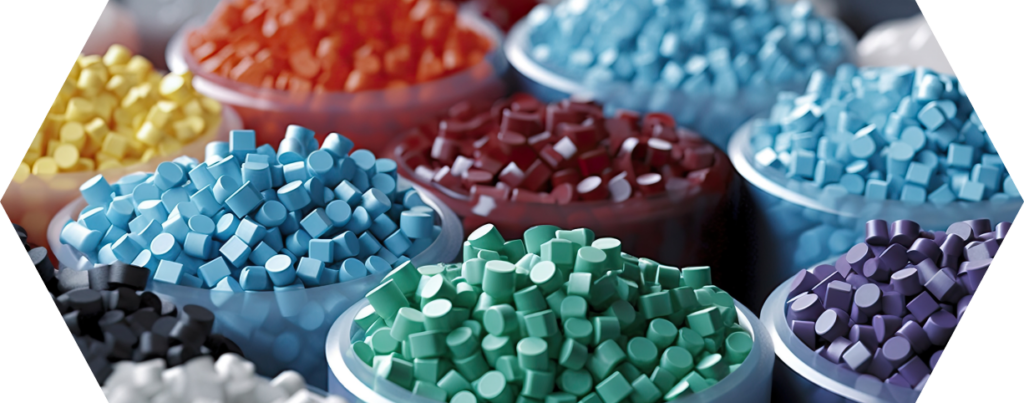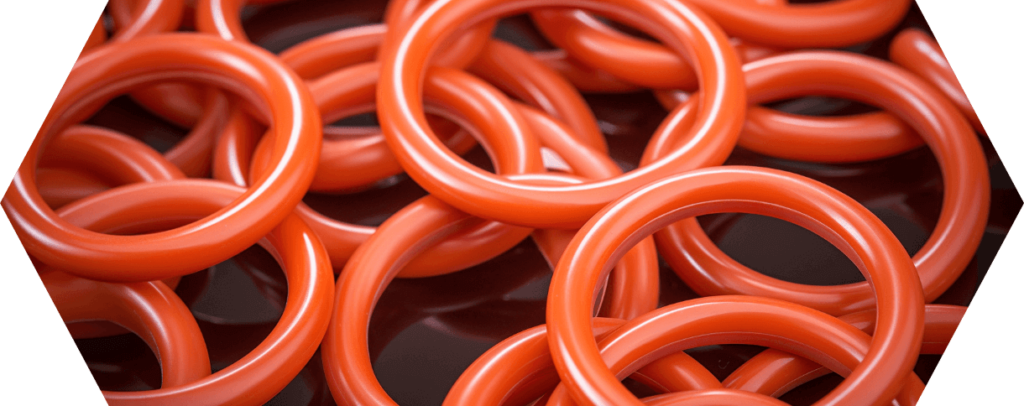10 questions: O-RING data sheet
#1 What is an O-ring data sheet?
An O-ring data sheet is a technical document that describes the specific properties and dimensions of an O-ring in detail.
It contains information such as material composition, degree of hardness, temperature resistance, pressure ranges, as well as physical and chemical resistance.
This data is crucial for engineers and technicians to ensure the correct selection and application of O-rings in various machines and systems. It serves as a guide for correct installation and maintenance to ensure optimal sealing and longevity.
| Information | Description |
|---|---|
| Purpose | Description of specific properties and dimensions of O-rings |
| Contents | Material composition, degree of hardness, temperature and pressure resistance |
| Users | Engineers, technicians |
| Significance | Selection, application, installation and maintenance of O-rings |
| Aim | Optimum sealing and durability |
REQUEST O-RINGS QUICKLY AND EASILY?
Almost any dimension available
Offer received in record time
No minimum order quantities or minimum item values
One contact for all concerns
#2 What are O-ring data sheets used for?
O-ring data sheets are used to define and communicate the exact specifications and performance characteristics of O-rings.
They enable engineers and technicians to determine the suitability of a particular O-ring for a specific application by providing detailed information on material compatibility, size, temperature and pressure resistance.
These datasheets are critical to selecting the right O-ring to ensure effective sealing and minimize the risk of failure in critical applications. They serve as a basic resource for design, maintenance and quality assurance.
| Intended use | Description |
|---|---|
| Specifications | Defines precise dimensions and performance characteristics |
| Application selection | Helps to select the appropriate O-ring for specific applications |
| Design support | Provides necessary information for the design of sealing systems |
| Quality assurance | Serves as a reference for checking quality and suitability |
| Maintenance guide | Assists in the correct maintenance and replacement of O-rings |

#3 Which materials are listed in O-ring data sheets?
O-ring data sheets list various materials that are used for the manufacture of O-rings.
These include nitrile rubber (NBR), fluororubber (FKM), ethylene propylene diene monomer (EPDM), silicone and polytetrafluoroethylene (PTFE) as well as special compounds for special requirements. Each material is described in terms of its chemical resistance, temperature tolerances and mechanical properties.
Material selection is based on the specific application of the O-ring, including exposure to chemicals, pressure conditions and operating temperatures, to ensure optimum performance and durability.
| material | Properties | Area of application |
|---|---|---|
| NBR (nitrile rubber) | Oil and fuel resistant | Standard applications |
| FKM (fluororubber) | High temperature and chemical resistance | High performance applications |
| EPDM | Good weather and ozone resistance | Outdoor applications |
| Silicone | Flexible at low temperatures | Food and medical sector |
| PTFE | Extremely resistant to chemicals | Chemical processing |

#4 Which physical properties are included in the O-ring data sheet?
An O-ring data sheet contains various physical properties that are decisive for the selection and application of the O-ring.
These include the hardness (specified in Shore A), the temperature resistance (minimum and maximum), the tensile strength, the elongation to break and the compression set.
These properties provide information about the mechanical strength, flexibility and long-term performance of the O-ring under specific operating conditions. Knowing this data makes it possible to select the most suitable O-ring for an application to ensure reliable sealing and optimum service life.
| Feature | Significance | Influence on the application |
|---|---|---|
| Hardness (Shore A) | Resistance to indentation | Selection for pressure resistance |
| Temperature resistance | Operating range in terms of temperature | Use in environments with extreme temperatures |
| Tensile strength | Resistance to tearing | Mechanical strength |
| Stretch to break | Flexibility and extensibility | Adaptability to dynamic loads |
| Compression set | Deformation behavior under load | Long-term stability and sealing performance |

#5 How is the compression set determined?
The compression set (PVR) is an important measure of the long-term performance and elasticity of O-rings and other elastomer seals.
It indicates how much a material remains permanently deformed after a certain loading and unloading period. The compression set is determined in several steps:
-
Sample preparation: First, the O-ring or sealing material is brought to a standardized size and shape.
-
Initial measurement: The original dimensions of the sample are precisely measured and documented.
-
Load: The sample is subjected to a defined load corresponding to a specific percentage of its original height. This load is maintained for a defined period of time, often at a specific temperature.
-
Unloading and recovery phase: After the loading time has elapsed, the sample is unloaded and stored at room temperature for a certain recovery period.
-
Final measurement: After the recovery phase, the dimensions of the sample are measured again.
-
Calculation of the PVR: The compression set is calculated as a percentage of the permanent deformation in relation to the original height of the sample.
| Step | Step Description | Purpose |
|---|---|---|
| Sample preparation | Standardization of the sample | Comparability |
| Initial measurement | Documentation of the original dimensions | Reference point |
| Load | Application of the defined load and predefined temperature | Simulation of the operating conditions |
| Relief and recovery | Relief and time for reshaping | Assessment of material recovery |
| Final measurement | Measurement after recovery phase | Determination of permanent deformation |
| Calculation of the PVR | Determination of the percentage of deformation | Evaluation of long-term performance |

#6 What is the difference between tensile strength and elongation at break?
Tensile strength and elongation at break are two fundamental mechanical properties that describe the behavior of materials under tensile load.
Both provide important information about the performance of a material, particularly in the context of sealing elements such as O-rings. However, they describe different aspects of the material behavior.
-
Tensile strength: The tensile strength is a measure of the maximum tensile stress that a material can withstand before it breaks. It is given in units of force per unit area (e.g. megapascals, MPa). The tensile strength provides information on how much load or stress a material can tolerate without failing. High tensile strength is an indicator of a strong material that can withstand high loads.
-
Elongation at break: Elongation at break, on the other hand, describes how much a material can be stretched before it breaks. It is given as a percentage and represents the ability of a material to deform under tensile load before it breaks. A material with a high elongation at break can stretch considerably, which indicates a high degree of flexibility and toughness.
To summarize, tensile strength evaluates the strength of a material under load, while elongation at break is a measure of the ductility or flexibility of the material.
Both properties are decisive for the selection of materials for specific applications, whereby a balance between strength and flexibility is often desired.
| Feature | Unit Description | Unit | Meaning for material selection |
|---|---|---|---|
| Tensile strength | Maximum tensile stress before breakage | MPa (Megapascal) | Indicator for the strength of the material |
| Elongation at break | Elongation until break | Percent (%) | Measure of flexibility and toughness |

#7 What is the difference between Shore A, Shore D and IRHD?
Shore A, Shore D and IRHD (International Rubber Hardness Degrees) are three different scales for measuring the hardness of elastomers and plastics.
These hardness measurements are crucial for the selection of materials in the manufacturing and construction industry, as they provide information on material stiffness and elasticity.
Each scale has specific areas of application and measures hardness in different ways.
-
Shore A: This scale is most commonly used to measure the hardness of soft to medium-hard elastomers. Shore A measures how deep a specified test specimen can penetrate the material under a defined force. Typical applications include rubber and soft plastics. Values range from 0 (very soft) to 100 (hard rubber).
-
Shore D: Shore D is used for harder plastics and elastomers. Similar to Shore A, the scale determines the penetration depth of a test specimen, but with a sharper and harder tip to measure the hardness of harder materials. Values on the Shore D scale are also between 0 and 100, with higher values indicating greater hardness.
-
IRHD: The IRHD method is another common hardness measurement for elastomers that uses similar physical principles to Shore hardness measurements, but is differentiated in its methodology and scaling. IRHD measures the indentation depth of a spherical indenter under a specific load. The scale typically ranges from 0 to 100, with lower values representing softer materials. IRHD is often used for precision engineering applications where high measurement accuracy is required.
| Hardness measurement | Use for | scale | Measuring principle |
|---|---|---|---|
| Shore A | Soft to medium-hard elastomers | 0-100 | Penetration depth of a test specimen |
| Shore D | Harder plastics and elastomers | 0-100 | Penetration depth of a harder test specimen |
| IRHD | Precise measurements on elastomers | 0-100 | Penetration depth of a spherical indenter |

#8 How are the parameters on a data sheet checked?
The parameters on a data sheet for materials such as O-rings and other sealing elements are usually determined by tests on standardized test specimens and not directly on the finished part.
This approach has specific advantages and disadvantages that must be taken into account when evaluating the data sheet information.
Determining the parameters
-
Standardized test specimens: The tests to determine material properties such as hardness, tensile strength, elongation at break and temperature resistance are carried out using standardized test specimens. These test specimens have defined dimensions and shapes that comply with international standards.
-
Test procedure: Various test procedures are used to determine the material parameters. These include tensile tests, hardness measurements and chemical resistance tests, which are carried out under controlled conditions.
Advantages
- Comparability: The use of standardized test specimens enables the comparability of test results between different materials and manufacturers.
- Standardization: International standards for test procedures ensure consistent evaluation of material quality.
- Efficiency: The tests are optimized in laboratory environments and enable a fast and efficient evaluation of material properties.
Disadvantages
- Transferability to real applications: The results obtained on standardized test specimens do not always reflect the performance of the material in real-world applications, especially with complex geometries or specific loading conditions.
- Influence of production on material properties: Manufacturing processes can change the properties of the material, which is not taken into account in tests on test specimens.
| Aspect | Advantages | Disadvantages |
|---|---|---|
| Comparability | Enabled by standardized test specimens | Limitations in transferability to finished parts |
| Standardization | International standards ensure consistency | Cannot fully reflect the diversity of applications |
| Efficiency | Fast and efficient test procedures | Potential deviations due to manufacturing processes |

#9 For which medium does the temperature resistance on data sheets apply?
The temperature resistance stated on the data sheets of materials such as O-rings or other sealing elements typically refers to the performance of the material in air.
This standardization makes it possible to carry out a general evaluation of material performance under thermal conditions.
However, it is important to understand that the actual temperature resistance of a material can vary considerably depending on the contact medium.
Meaning of the indication in air
- Basic comparison: The specification of the temperature resistance in air serves as a basic comparison for the evaluation and selection of materials.
- Standardization: Since air as a medium is easy to standardize, this specification provides a consistent basis for material testing.
Influence of the contact medium
- Chemical interaction: Chemical media can influence the properties of the material at different temperatures. Some media can accelerate material degradation or increase or decrease the temperature tolerance of the material.
- Specific data sheets: For applications that require contact with specific media, manufacturers often provide specialized data sheets or guidelines that describe the temperature resistance of the material in these specific media.
Consideration for applications
- Application-related selection: When selecting a suitable material, it is crucial to consider not only the general temperature resistance in air, but also the specific application conditions and the contact medium.
- Consultation with manufacturers: In case of doubt, users should consult the manufacturers to obtain detailed information on the performance of the material in specific chemical media and at different temperatures.
| Aspect | Meaning | Notes |
|---|---|---|
| Standard specification in air | Basic comparison of material performance | Applies as a general guide value |
| Influence of the medium | Varying temperature resistance | Specific guidelines for accurate assessment |
| Application-related selection | Consideration of the operating conditions | Consultation with manufacturers for optimum material selection |

#10 What is the TR-10 value?
The TR-10 value is an important parameter in materials science, especially when evaluating the low-temperature flexibility of elastomers and rubber.
TR-10 stands for “Temperature Retraction 10%”, which is the temperature at which a standardized pre-expanded sample material retracts by 10% of its original elongation after being subjected to a cold treatment.
This value is a direct measure of the cold tolerance of a material and provides information on the minimum temperature up to which the material remains flexible and retains its elastic properties.
Determination of the TR-10 value
- Preparation: A sample of the material is pre-stretched to a certain length.
- Cooling: The pre-stretched sample is then cooled, often in a programmable cooling bath that gradually lowers the temperature.
- Measurement: The temperature at which the sample recovers 10% of its original elongation is recorded as the TR-10 value.
Meaning of the TR-10 value
- Cold resistance: A lower TR-10 value indicates better cold flexibility, as the material remains flexible even at lower temperatures.
- Material selection: The TR-10 value helps in the selection of materials for applications that require a high cold tolerance, such as seals in outdoor applications or in cryogenic systems.
- Performance comparison: The TR-10 value makes it possible to compare the cold tolerance of different materials under standardized conditions.
| Parameters | Meaning | Application |
|---|---|---|
| TR-10 value | Measure for cold tolerance | Selection of cold-tolerant materials |
| Cold flexibility | Ability to retain elastic properties in cold conditions | Design of critical components |
“I am convinced that we should share our knowledge with the world. I hope I have been able to answer all your questions. If you have any further questions, please feel free to contact us at any time. We will be happy to help you.”

Lord of the O-rings
Author of the Sealing Academy
